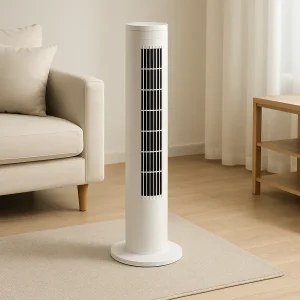Choosing the right fan for your space can feel overwhelming. With so many types—each claiming to offer efficiency—it’s easy to make a costly mistake. But when airflow, energy savings, and cost efficiency matter most, understanding fan types is your best solution.
The most efficient fan type depends on your space and purpose. For large areas, HVLS and centrifugal fans are the most energy-efficient. For homes or offices, ceiling fans, tower fans, and smart pedestal fans offer effective cooling with low energy use.

Industrial HVLS fans installed in warehouse ceiling
Fan efficiency isn’t just about speed or how strong the breeze feels—it’s about how much aria che un ventilatore può spostare with the least amount of consumo di energia. Efficiency varies based on:
Fans that spostare l'aria effectively while drawing minimal power reduce operating costs, improve comfort, and lower environmental impact. High-efficiency fans also produce less noise and last longer with proper care.
Key efficiency measures:
| Caratteristica | Efficient Fans Offer |
|---|---|
| Airflow Volume | High CFM rating for space coverage |
| Energy Use | Low wattage or energy star rated |
| Durata | Industrial-grade motor, bearings, and housing |
| Smart Control | Variable speed, motion sensor, or remote |
To make a smart decision, it’s essential to compare different tipi di ventilatori and their efficiency across real-world applications.
Ventilatori centrifughi are commonly used in industrial settings where high pressure airflow is necessary. These fans pull air into the fan wheel and push it out at a 90-degree angle, creating high static pressure—ideal for ductwork, sistemi di ventilazione, E ad alta temperatura ambienti.
Why centrifugal fans work best:
However, centrifugal fans are usually larger, noisier, and more expensive than ventilatori a torre O ventilatori a piantana. They are efficient in specific environments, not for household cooling.
Explore how centrifugal fans work in large commercial setups
Ventilatori assiali, on the other hand, are widely used across applications—from cooling fan units in electronics to large-scale raffreddamento industriale. They operate by moving air parallel to the fan blade axis and are best for situations needing high airflow at low pressure.
Axial fans tend to consume less energy when not battling pressure loads, making them more energy efficient in open spaces.
Tower fans are a popular choice in homes and offices due to their compact size, modern design, and oscillating airflow. Although they don’t produce high CFM like industrial fans, they far circolare l'aria well in small to medium rooms.
However, the velocità della ventola and airflow power are limited compared to ventilatori assiali O ventilatori centrifughi. If you’re choosing a fan to cover large areas like magazzini O palestre, tower fans are not the best option.

Slim tower fan for home use
Ventilatori a piantana E ventilatori da tavolo are flexible and portable, making them perfect for temporary or personal cooling. These electric fans can be easily moved between rooms, adjusted for velocità della ventola, and tilted to direct airflow.
While they offer decent energy savings and airflow direction control, pedestal and table fans are not designed to spostare grandi quantità di aria. They are not suitable for environments requiring strong, continuous ventilazione or cooling.
SÌ-ventilatori da soffitto remain one of the best ways to far circolare l'aria efficiently, especially in industriale O commerciale spaces with high ceilings. Their energy draw is minimal compared to aria condizionata units, and they help keep aria calda down in the winter and aria fresca moving in summer.
Modern ceiling fans, especially Ventilatori HVLS (high-volume, low-speed), offer massive risparmio energetico. Questi i fan funzionano efficientemente in fabbriche, palestre, E centri sportivi, delivering comfort with low operating costs.
Discover how ceiling fans help cool large facilities
Bladeless fans are quieter and safer, with a futuristic design that draws air into the base and pushes it through a ring to aria fresca effectively. They’re best for homes or offices prioritizing safety and aesthetics.
Smart fans, whether tower or piedistallo, integrate with apps and voice assistants, allowing users to set timers, schedules, and speed automatically. They offer convenience and efficienza energetica when cooling is needed in short bursts.
However, these fans are often costly and are more suited to personal use rather than ventilatori industriali needs. For large facilities, centrifugo O Ventilatori HVLS remain the best options.
Quando si tratta di raffreddamento industriale, only certain tipi di ventilatori meet the demand for volumi d'aria, low noise, E long-term durability.
Ogni tipo di ventilatore has specific applications. For example, ventilatori centrifughi maniglia ad alta temperatura, servizio continuo operations. Ventilatori HVLS sono ideali per cooling your home or business efficiently without high energy bills.

ventilatore hvls in un grande magazzino
When selecting a fan to move air across wide or tall areas, it’s important to consider progettazione del ventilatore, pala del ventilatore size, and application. Here’s how some different types of fans compare:
| Tipo di ventola | Il migliore per | Efficienza | Copertura |
|---|---|---|---|
| Tower fan | Bedrooms, offices | Moderare | Small |
| Ventilatore a piantana | Personal cooling | Good | Medio |
| Ceiling fan / HVLS fan | Warehouses, gyms | Eccellente | Very large |
| Ventilatore centrifugo | Industrial exhaust | Alto | Alta pressione |
| Ventilatore assiale | General ventilazione | Alto | Wide area |
| Smart fan | Homes, offices | Good | Small to medium |
| Bladeless fan | Safety and style | Moderare | Small |
Axial fans move air in a straight path, making them great for continuous aria condizionata or supply needs. Ventilatori centrifughi pull air into the center and push it out at a 90-degree angle, useful in high-pressure, ducted sistemi.
Ventilatori HVLS (alto volume, bassa velocità) rappresentano l'apice di ventilatore industriale engineering. These large ventilatori da soffitto span up to 24 feet and spostare l'aria gently but thoroughly across vast spaces.
These fans are not just about airflow—they impact your facility’s overall consumo di energia, comfort, E operating costs. Compared to traditional condizionatore d'aria units, HVLS fans provide better ROI, especially when paired with smart controls.
Explore more: HVLS fans for commercial applications
UN energy-efficient fan balances flusso d'aria with minimal power usage. This depends on:
To achieve risparmio energetico, many businesses switch from electric fans E air conditioners to HVLS or ventilatori centrifughi for long-term savings.
Scegliere il ventilatore destro depends on your specific space and needs. Ask:
If you manage a facility such as a magazzino, palestra, O fabbrica, the right answer is almost always an ventilatore industriale like HVLS or centrifugo types.
How to select the best HVLS fan for your factory
Which type of fan is most energy-efficient?
The most energy-efficient fan is the HVLS (High Volume Low Speed) fan for large commercial or industrial spaces. For residential settings, ventilatori da soffitto con stella energetica certification and brushless DC motors offer excellent efficiency.
What is the difference between axial and centrifugal fans?
Ventilatori assiali move air in a straight line and are best for moving large volumes at low pressure. Ventilatori centrifughi, on the other hand, are designed to generate higher pressure and are ideal for ducted O ventilatore di scarico sistemi.
Do fans really help with air conditioning efficiency?
Yes. Fans, especially ventilatori da soffitto, help far circolare l'aria and reduce hot or cold spots. This lets you raise the termostato in summer or lower it in winter, reducing consumo di energia without sacrificing comfort.
Are bladeless fans worth it?
Bladeless fans offer safety, quiet operation, and modern design. However, they typically spostare meno aria than traditional pala del ventilatore models and may not be ideal for raffreddamento industriale.
Which fan works best for gyms or sports centers?
Grande Ventilatori HVLS are the best option. They cover wide areas, far circolare l'aria efficiently, and provide raffreddamento without noisy operation, making them ideal for athletic facilities.
How often should I maintain industrial fans?
It’s recommended to follow a strict programma di manutenzione: check for vibrazione, lubricate bearings, inspect motore health, and clean the pale del ventilatore every 3–6 months for optimal performance.
To wrap up, here’s what you need to remember when choosing the most ventilatore efficiente for your space:
Whether you’re managing a fabbrica, outfitting a commercial gym, O installing ventilation in a magazzino, selecting the right tipo di ventilatore ensures better comfort and efficienza energetica.

Ciao, sono Michael Danielsson, CEO di Vindus Fans, con oltre 15 anni di esperienza nel settore dell'ingegneria e della progettazione. Sono qui per condividere ciò che ho imparato. Se avete domande, non esitate a contattarmi in qualsiasi momento. Cresciamo insieme!